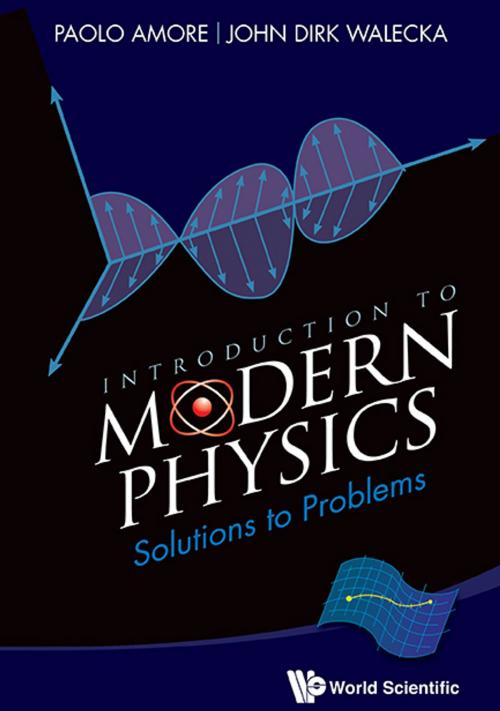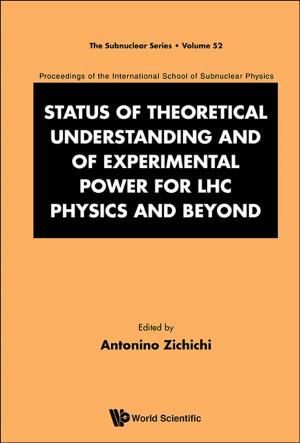Introduction to Modern Physics
Solutions to Problems
Nonfiction, Science & Nature, Science, Physics, Quantum Theory, General Physics| Author: | Paolo Amore, John Dirk Walecka | ISBN: | 9789814520331 |
| Publisher: | World Scientific Publishing Company | Publication: | August 16, 2013 |
| Imprint: | WSPC | Language: | English |
| Author: | Paolo Amore, John Dirk Walecka |
| ISBN: | 9789814520331 |
| Publisher: | World Scientific Publishing Company |
| Publication: | August 16, 2013 |
| Imprint: | WSPC |
| Language: | English |
Our understanding of the physical world was revolutionized in the twentieth century — the era of “modern physics”. The book Introduction to Modern Physics: Theoretical Foundations, aimed at the very best students, presents the foundations and frontiers of today's physics. Typically, students have to wade through several courses to see many of these topics. The goal is to give them some idea of where they are going, and how things fit together, as they go along.
The book focuses on the following topics: quantum mechanics; applications in atomic, nuclear, particle, and condensed-matter physics; special relativity; relativistic quantum mechanics, including the Dirac equation and Feynman diagrams; quantum fields; and general relativity. The aim is to cover these topics in sufficient depth that things “make sense” to students, and they achieve an elementary working knowledge of them. The book assumes a one-year, calculus-based freshman physics course, along with a one-year course in calculus. Several appendices bring the reader up to speed on any additional required mathematics. Many problems are included, a great number of which take dedicated readers just as far as they want to go in modern physics.
The present book provides solutions to the over 175 problems in Introduction to Modern Physics: Theoretical Foundations in what we believe to be a clear and concise fashion.
Contents:
-
Introduction
-
Classical Physics
-
Some Contradictions
-
Quantum Mechanics
-
Atomic Physics
-
Nuclear Physics
-
Particle Physics
-
Special Relativity
-
Relativistic Quantum Mechanics
-
General Relativity
-
Quantum Fluids
-
Quantum Fields
-
Appendices:
- Mathematica Program for Problem 2.5
- Matrices
- Fourier Series and Fourier Integrals
- Some Thermodynamics
- Some Statistical Mechanics
- Some Vector Calculus
- Black Body Flux
- Wave Functions for Identical Particles
- Transition Rate
- Neutrino Mixing
- Units
Readership: Upper-level undergraduate physics or science students, research scientists and engineers.
Key Features:
- Provides solutions to the over 175 problems in the book Introduction to Modern Physics: Theoretical Foundations
- Problems enhance and extend the coverage in that text
- Solutions are presented in a clear and concise fashion
- Provides a learning aid for students
- Provides a teaching aid for instructors
Our understanding of the physical world was revolutionized in the twentieth century — the era of “modern physics”. The book Introduction to Modern Physics: Theoretical Foundations, aimed at the very best students, presents the foundations and frontiers of today's physics. Typically, students have to wade through several courses to see many of these topics. The goal is to give them some idea of where they are going, and how things fit together, as they go along.
The book focuses on the following topics: quantum mechanics; applications in atomic, nuclear, particle, and condensed-matter physics; special relativity; relativistic quantum mechanics, including the Dirac equation and Feynman diagrams; quantum fields; and general relativity. The aim is to cover these topics in sufficient depth that things “make sense” to students, and they achieve an elementary working knowledge of them. The book assumes a one-year, calculus-based freshman physics course, along with a one-year course in calculus. Several appendices bring the reader up to speed on any additional required mathematics. Many problems are included, a great number of which take dedicated readers just as far as they want to go in modern physics.
The present book provides solutions to the over 175 problems in Introduction to Modern Physics: Theoretical Foundations in what we believe to be a clear and concise fashion.
Contents:
-
Introduction
-
Classical Physics
-
Some Contradictions
-
Quantum Mechanics
-
Atomic Physics
-
Nuclear Physics
-
Particle Physics
-
Special Relativity
-
Relativistic Quantum Mechanics
-
General Relativity
-
Quantum Fluids
-
Quantum Fields
-
Appendices:
- Mathematica Program for Problem 2.5
- Matrices
- Fourier Series and Fourier Integrals
- Some Thermodynamics
- Some Statistical Mechanics
- Some Vector Calculus
- Black Body Flux
- Wave Functions for Identical Particles
- Transition Rate
- Neutrino Mixing
- Units
Readership: Upper-level undergraduate physics or science students, research scientists and engineers.
Key Features:
- Provides solutions to the over 175 problems in the book Introduction to Modern Physics: Theoretical Foundations
- Problems enhance and extend the coverage in that text
- Solutions are presented in a clear and concise fashion
- Provides a learning aid for students
- Provides a teaching aid for instructors















